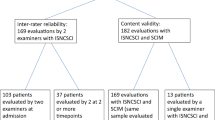Abstract
Study design:
To study the vasomotor responses (skin axon-reflex vasodilatation (SkARV) to stimulation of the skin in spinal cord injury (SCI) patients.
Objective:
To assess the completeness of the sympathetic injury and to define the sympathetic level of lesion in paraplegic and tetraplegic patients.
Setting:
Centre Calve, Fondation Hopale and Centre Bouffard-Vercelli, France.
Subjects:
A total of 81 SCI patients ranging from C2 to L2.
Method:
A mechanical stimulation was applied to the skin on both sides of the trunk, using a blunt instrument. The presence of an abnormal response below the lesion helped define the sympathetic level.
Results:
Above the lesion, SkARV was observed in all patients. In patients with a complete sympathetic injury, the response below the lesion was either a vasoconstrictor response in upper motor neuron lesions, or total absence of SkARV in lower motor neuron lesions. There was excellent correspondence between complete somatic (American Spinal Injury Association (ASIA) A) and complete sympathetic lesions (100% of paraplegic and 94% of tetraplegic patients), whereas an incomplete somatic (ASIA B–D) lesion was often associated with a complete sympathetic lesion. In 34% of complete ASIA A patients, a sympathetic zone of partial preservation was found, extending below the lesion on sensory denervated dermatomes.
Conclusion:
SkARV is a simple bedside test that allows the assessment of sympathetic completeness of injury across the lesion as well as the excitability of the isolated spinal cord. We suggest that the definition of sympathetic level should be part of the classification of complete thoracic SCI.
Similar content being viewed by others
Log in or create a free account to read this content
Gain free access to this article, as well as selected content from this journal and more on nature.com
or
References
Anand P . Skin axon-reflex vasodilatation—mechanisms, testing and implications in autonomic disorders. In: Bannister R, Mathias CJ (eds). Autonomic Failure, 3rd edn. Oxford University Press: Oxford, 1992, pp 479–488.
Kuesgen B, Frankel HL, Anand P . Decreased cutaneous sensory axon-reflex vasodilatation below the lesion in patients with complete spinal cord injury. Somatosens Mot Res 2002; 19: 149–152.
Thomas A . Les moyens d'exploration du systeme sympathique et leur valeur. Rev Neurol 1926; 1: 767–928.
Guttmann L . Disturbances of vasomotor control. Spinal Cord Injuries: Comprehensive Management and Research. Blackwell: Oxford, 1976, pp 295–330.
Chapelle P . Valeur séméiologique des syndromes lésionnels cérébro-spinal et végétatif: étude critique. Ann Méd Phys 1978; 21: 507–517.
Krassioukov AV, Karlsson AK, Wecht JM, Wuermser LA, Mathias CJ, Marino RJ . Assessment of autonomic dysfunction following spinal cord injury: rationale for additions to International Standards for Neurological Assessment. J Rehabil Res Dev 2007; 44: 103–112.
Marino RJ, Barros T, Biering-Sorensen F, Burns SP, Donovan WH, Graves DE et al. International standards for neurological classification of spinal cord injury. J Spinal Cord Med 2003; 26 (Suppl 1): S50–S56.
Shields Jr RW . Functional anatomy of the autonomic nervous system. J Clin Neurophysiol 1993; 10: 2–13.
Claydon VE, Krassioukov AV . Clinical correlates of frequency analyses of cardiovascular control after spinal cord injury. Am J Physiol Heart Circ Physiol 2008; 294: H668–H678.
Brown R, Engel S, Wallin BG, Elam M, Macefield V . Assessing the integrity of sympathetic pathways in spinal cord injury. Auton Neurosci 2007; 134: 61–68.
Previnaire JG, Soler JM, Hanson P . Skin potential recordings during cystometry in spinal cord injured patients. Paraplegia 1993; 31: 13–21.
Alexander MS . Autonomic function and spinal cord injury: are we at a crossroads? Spinal Cord 2008; 46: 402–405 (doi:10.1038/sj.sc.3102165).
Sipski M, Alexander C, Gomez-Marin O, Spalding J . The effects of spinal cord injury on psychogenic sexual arousal in males. J Urol 2007; 177: 247–251.
Soler JM, Previnaire JG, Plante P, Denys P, Chartier-Kastler E . Midodrine improves ejaculation in spinal cord injured men. J Urol 2007; 178: 2082–2086.
Mathias CJ . Orthostatic hypotension and paroxysmal hypertension in humans with high spinal cord injury. Prog Brain Res 2006; 152: 231–243.
Nicotra A, Asahina M, Young TM, Mathias CJ . Heat-provoked skin vasodilatation in innervated and denervated trunk dermatomes in human spinal cord injury. Spinal Cord 2006; 44: 222–226.
Karlsson AK . Autonomic dysreflexia. Spinal Cord 1999; 37: 383–391.
Catz A, Bluvshtein V, Pinhas I, Akselrod S, Gelernter I, Nissel T et al. Cold pressor test in tetraplegia and paraplegia suggests an independent role of the thoracic spinal cord in the hemodynamic responses to cold. Spinal Cord 2008; 46: 33–38.
Cariga P, Catley M, Mathias CJ, Savic G, Frankel HL, Ellaway PH . Organisation of the sympathetic skin response in spinal cord injury. J Neurol Neurosurg Psychiatry 2002; 72: 356–360.
Karamehmetoglu S, U∂ur M, Aslan Y, Palamar D, Gökdemir A . The determination of the level of spinal cord injury according to the measurement of skin resistance. 46th ISCoS Annual Scientific Meeting, Reykjavík 2007.
Author information
Authors and Affiliations
Corresponding author
Rights and permissions
About this article
Cite this article
Previnaire, J., Soler, J., El Masri, W. et al. Assessment of the sympathetic level of lesion in patients with spinal cord injury. Spinal Cord 47, 122–127 (2009). https://doi.org/10.1038/sc.2008.87
Received:
Revised:
Accepted:
Published:
Issue date:
DOI: https://doi.org/10.1038/sc.2008.87
Keywords
This article is cited by
-
Autonomic Dysreflexia After Spinal Cord Injury: Beyond the Basics
Current Physical Medicine and Rehabilitation Reports (2020)
-
Dartos reflex as autonomic assessment in persons with spinal cord injury
Spinal Cord Series and Cases (2017)
-
Spinal cord injury-induced immunodeficiency is mediated by a sympathetic-neuroendocrine adrenal reflex
Nature Neuroscience (2017)
-
How reliable are sympathetic skin responses in subjects with spinal cord injury?
Clinical Autonomic Research (2015)
-
Severity of autonomic dysfunction in patients with complete spinal cord injury
Clinical Autonomic Research (2012)



